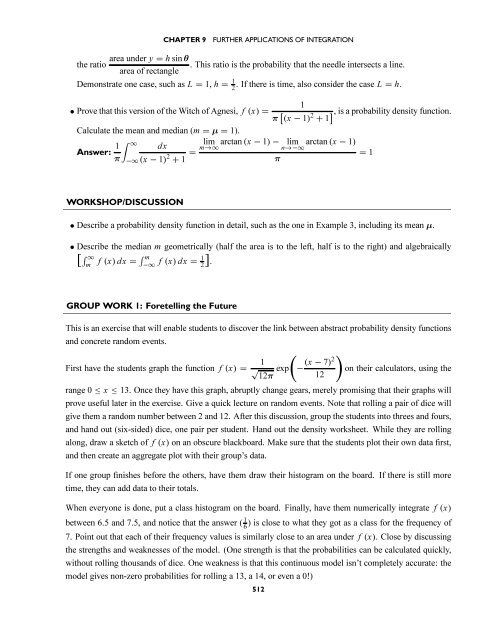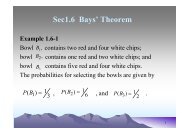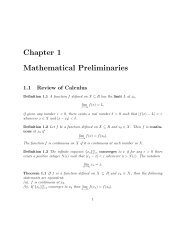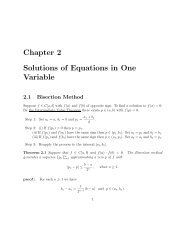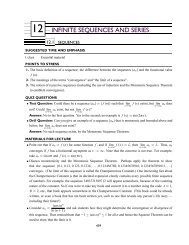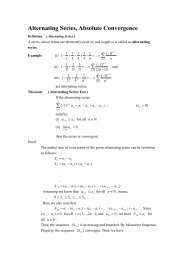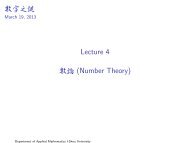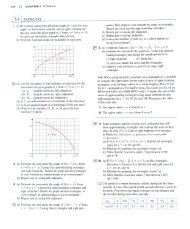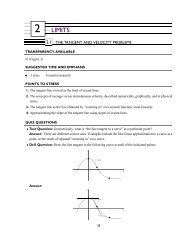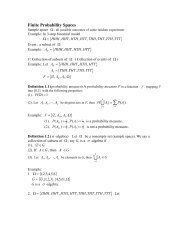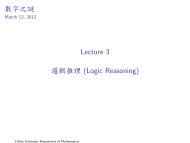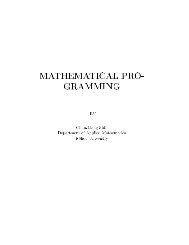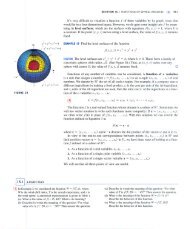9 FURTHER APPLICATIONS OF INTEGRATION
9 FURTHER APPLICATIONS OF INTEGRATION
9 FURTHER APPLICATIONS OF INTEGRATION
Create successful ePaper yourself
Turn your PDF publications into a flip-book with our unique Google optimized e-Paper software.
CHAPTER 9<br />
<strong>FURTHER</strong> <strong>APPLICATIONS</strong> <strong>OF</strong> <strong>INTEGRATION</strong><br />
area under y = h sin θ<br />
the ratio . This ratio is the probability that the needle intersects a line.<br />
area of rectangle<br />
Demonstrate one case, such as L = 1, h = 1 2<br />
. If there is time, also consider the case L = h.<br />
1<br />
• Prove that this version of the Witch of Agnesi, f (x) =<br />
π [ (x − 1) 2 ], is a probability density function.<br />
+ 1<br />
Calculate the mean and median (m = μ = 1).<br />
Answer: 1 ∫ ∞<br />
dx<br />
lim arctan (x − 1) − lim arctan (x − 1)<br />
π (x − 1) 2 + 1 = m→∞ n→−∞<br />
= 1<br />
π<br />
−∞<br />
WORKSHOP/DISCUSSION<br />
• Describe a probability density function in detail, such as the one in Example 3, including its mean μ.<br />
• Describe the median m geometrically (half the area is to the left, half is to the right) and algebraically<br />
[ ∫ ∞<br />
m<br />
f (x) dx = ∫ m<br />
−∞ f (x) dx = 1 2].<br />
GROUP WORK 1: Foretelling the Future<br />
This is an exercise that will enable students to discover the link between abstract probability density functions<br />
and concrete random events.<br />
First have the students graph the function f (x) = √ 1<br />
( )<br />
(x − 7)2<br />
exp − on their calculators, using the<br />
12π 12<br />
range 0 ≤ x ≤ 13. Once they have this graph, abruptly change gears, merely promising that their graphs will<br />
prove useful later in the exercise. Give a quick lecture on random events. Note that rolling a pair of dice will<br />
give them a random number between 2 and 12. After this discussion, group the students into threes and fours,<br />
and hand out (six-sided) dice, one pair per student. Hand out the density worksheet. While they are rolling<br />
along, draw a sketch of f (x) on an obscure blackboard. Make sure that the students plot their own data first,<br />
and then create an aggregate plot with their group’s data.<br />
If one group finishes before the others, have them draw their histogram on the board. If there is still more<br />
time, they can add data to their totals.<br />
When everyone is done, put a class histogram on the board. Finally, have them numerically integrate f (x)<br />
between 6.5 and 7.5, and notice that the answer ( 1 6<br />
) is close to what they got as a class for the frequency of<br />
7. Point out that each of their frequency values is similarly close to an area under f (x). Close by discussing<br />
the strengths and weaknesses of the model. (One strength is that the probabilities can be calculated quickly,<br />
without rolling thousands of dice. One weakness is that this continuous model isn’t completely accurate: the<br />
model gives non-zero probabilities for rolling a 13, a 14, or even a 0!)<br />
512


